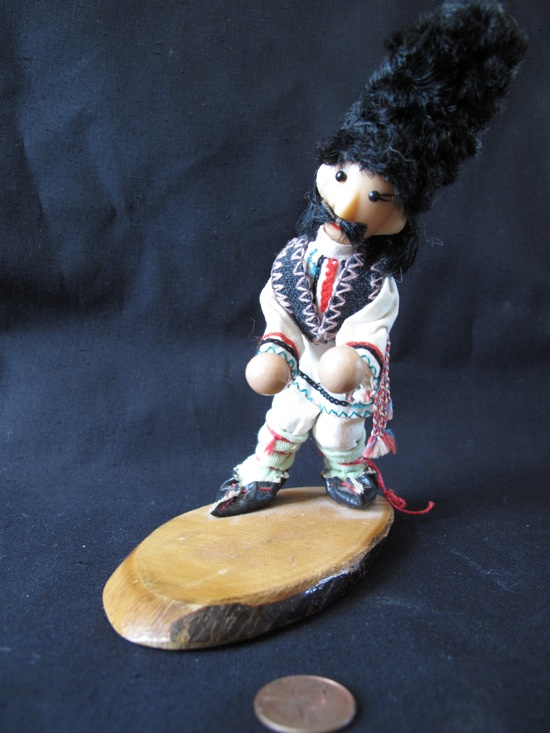Do you want to hear a strange story?
Well, I’ll tell you a strange story.
This is about one of the greatest social experiments ever done.
It goes like this. Between July to November 2009, two journalists — Joshua Glenn and Rob Walker — decided to do something quite unusual:
- They took a walk around New York City. Visiting thrift stores, flea markets, and garage sales. They bought 100 items. These were totally random objects.
- Cups. Dolls. Figurines. Sculptures. Ornaments. Bottles.
- Glenn and Walker bought anything and everything. They weren’t particularly picky.
- Altogether, they spent a grand total of $128.74 for their haul of garage-sale trinkets. Some people might actually call these objects junk.
Then, following their shopping spree, Glenn and Walker decided to do something even more unusual:
- They recruited a team of writers. They asked these writers to create individual stories for each object. Their goal? To be as imaginative as possible.
- Once this was done, Glenn and Walker listed each item for sale on eBay (the American version of Trade Me).
- Their intention here was to set a low bidding price for every object. Then they would sit back and observe how much people would be willing to pay for them. This would be the ultimate exercise in free-market economics.

Source: Significant Objects
For example, here’s a cute Russian doll that was listed on eBay. Accompanying it was a story, written by Doug Dorst. Here’s how it goes:
This is an icon of the fourteenth-century Saint Vralkomir of Dnobst, the patron saint of extremely fast dancing. Handcrafted in a snowbound convent by the nimble-footed Sisters of the Vralkomirian Order, it was given to my grandmother—then a nine-year-old girl—as she boarded the ship that would take her to America from Dnobst, a narrow pie-wedge of land bounded by the Dnobst River, the Grkgåt Mountains, and the Great Western Fence of Count Pyør the Litigious.
Vralkomir was a competent cobbler, but he was brusque and taciturn, conversing only to the extent he was required to for business. His fellow citizens found him odd, and they would hurry back out into the year-round cold as quickly as they could. Some said his towering jet-black hat, which he’d knitted of his own hair, would trigger vertigo in those who stared up at it for too long. Many were annoyed by his incessant tuneless humming.
In the autumn of 1347, in response to a perceived slight from a Dnobstian maiden, the recently enthroned Tsar Nÿrdrag the Irascible (also known as “The Cowbird Tsar,” a Scandinavian foundling whom the previous Tsar and Tsarina unknowingly raised as their own) issued an edict banning fire in Dnobst. His armies confiscated every piece of flint and all the available kindling. When winter blew in, it was as cruel as Nÿrdrag himself. Icy gusts sent massive musk-elk rolling out of the forest like tumbleweeds. It snowed for weeks on end. Desperate and frostbitten, the townspeople (minus Vralkomir) huddled in the mayor’s house, which at least still had a roof. The temperature kept dropping. Death was coming, and they could do nothing but wait.
From a high window, someone saw Vralkomir leave his shop, glance around the empty village square, then trudge into the forest. He returned hauling a freshly cut tree. In the square, he sawed the wood into discs like the one you see on the icon. Vralkomir then hopped onto one of the discs and began dancing, dancing, dancing to the tuneless music in his head. He danced faster and faster. The villagers watched as he wheeled and spun and tappatapped, his legs and feet a blur in the subarctic gloom. A plume of smoke rose from under his feet, and he kept dancing, and then there was more smoke, and he danced on, and soon the wooden disc was ablaze. Vralkomir leapt to the next disc and set it alight, and the next, and the next, and the Dnobstians came out and gathered round the fires, drinking in the precious warmth, happy to be alive. The bearded man danced all winter, they say, as no one else in the village could duplicate his feat of terpsichorean ignition, and he died of exhaustion in mid-April, a beloved martyr. Some say he had stitched contraband flints into his soles; others claim he lit the fire with dance alone. My grandmother preferred the latter, and so do I.
My grandmother said that on frigid and moonless winter nights, effigies of St. Vralkomir may come to life and begin dancing, throwing sparks from their wooden pedestals. This was why she always kept the icon under a glass cover (which stylishly followed the contours of the saint’s mighty hair-hat). Unfortunately, I am a clumsy person, and I broke the glass last weekend while dusting. My wife now insists that I sell it, calling it “at best, a tacky, dust-collecting tchotchke, and at worst, a tacky, dust-collecting fire hazard.” There is no reasoning with her; she is descended from an unimaginative people who know nothing of heroes.
I hope someone will give St. Vralkomir the home he deserves. The icon is probably not a fire hazard, although for obvious reasons I can make no express guarantee.
Well, gosh. This is an imaginative story, isn’t it? It’s nostalgic. It’s whimsical. It’s charming. So, how did the auction for this Russian doll play out?
- Well, the opening price was set at $3.00. Pretty humble. Pretty realistic.
- But then, a fierce bidding war happened — and in the end, the price closed at $193.50.
- That’s a 6,350% increase. This is astonishing, isn’t it? Especially when you consider the fact that this was just a random object bought at a random flea market.
Meanwhile, the other 99 items that were listed on eBay also sold very well:
- You have to remember — Glenn and Walker originally spent $128.74 for their haul of garage-sale trinkets. Some people might actually call these objects junk.
- However, by dressing them up with amazing stories, Glenn and Walker managed to boost the perceived value of these items.
- Their final tally on eBay? Well, $3,612.51.
- That’s a profit of over $2,700%. Ka-ching!
The attraction of a good story?

Source: Image generated by OpenAI’s DALL-E
The success of the Significant Objects Experiment proves one thing:
- What is valuable and what’s not often will come down to storytelling. Indeed, stories are a very powerful thing. We rely on them to create meaning. To establish connections. To make sense of our world.
- Yes, you could argue that all physical objects have basic intrinsic worth. But, really, it’s emotion that actually boosts the selling price. This is why we are ready and willing to pay a premium for an item that we perceive as special.
So, what is true about garage-sale trinkets might also be true for the stock market:
- Over the past five years, American tech stocks have delivered an average return of over 170%. This has made information technology the best-performing sector in the S&P 500. You will notice that tech receives an unusual amount of admiration and worship in the media.
- Meanwhile, over the same time period, American financial stocks have delivered an average return of around 40%. So, understandably, finance receives nowhere near the same level of attention as tech.
Now, what is fascinating here is the huge gap in valuations:
- For the information-technology sector, the average price-to-earnings ratio is around 38.
- Meanwhile, for the financial sector, the price-to-earnings is around 13.
So, what does this mean?
- Well, it means that tech investors are paying approximately $38 for every $1 of actual earnings.
- Meanwhile, finance investors are paying approximately $13 for every $1 of actual earnings.
- So, fundamentally speaking, the average tech stock is 190% more expensive than the average financial stock.
Now, given this situation, why are investors paying for such eye-watering valuations in tech?
- Well, rightly or wrongly, this comes down to storytelling. It’s about the persuasive power of belief.
- Investors are willing to pay a premium because they believe that tech is special. It will continue to revolutionise. It will continue to outperform in terms of earnings potential.
Of course, you might argue that this perception may have been artificially induced. To a certain degree, it’s marketing hype. It’s shaped by the fact that we’ve had tech CEOs who are exceptionally good at storytelling:
- For example, the late Steve Jobs would regularly use what’s known as the ‘reality distortion field’. He would tell stories that were a mix of charisma, bravado, and exaggeration. By doing so, he boosted the perceived value of Apple [NASDAQ:AAPL] as a tech company, as well as a consumer brand.
- Meanwhile, it’s safe to assume that Elon Musk has done the same thing for Tesla [NASDAQ:TSLA], and Jensen Huang has done the same thing for Nvidia [NASDAQ:NVDA].
Ultimately, the strength of a compelling narrative can’t be ignored. After all, we do love a good yarn, don’t we?
- Nonetheless, as rational investors, it’s important for us to look beyond emotion. To look beyond the ‘reality distortion field’.
- We must understand the role that stories play in shaping the market. And we have to be cautious not to be swayed by irrational impulses. Being too greedy is just as bad as being too fearful.
While storytelling can inspire confidence and drive stock prices in the short-term, it’s actually fundamentals that will sustain value over the long-term:
- For this reason, our ability to bridge the gap between perception and reality can make all the difference.
- In the words of Warren Buffett: ‘Price is what you pay. Value is what you get.’
We want to hear from you
Your prosperity is our focus — which is why we are always working hard to uncover new opportunities beyond the radar for you. We’re eager for your feedback:
- If you have enjoyed this article, please consider leaving us a review.
- Let us know what you liked. Let us know what inspired you. Let us know if it’s made you a better investor.
Regards,
John Ling
Analyst, Wealth Morning
(This article is the author’s personal opinion and commentary only. It is general in nature and should not be construed as any financial or investment advice. Wealth Morning offers Managed Account Services for Wholesale or Eligible Investors as defined in the Financial Markets Conduct Act 2013.)





John is the Chief Investment Officer at Wealth Morning. His responsibilities include trading, client service, and compliance. He is an experienced investor and portfolio manager, trading both on his own account and assisting with high net-worth clients. In addition to contributing financial and geopolitical articles to this site, John is a bestselling author in his own right. His international thrillers have appeared on the USA Today and Amazon bestseller lists.